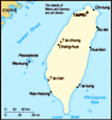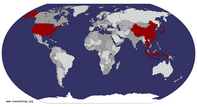Advertisement
Published: December 19th 2012

 Making fire
Making fire
Taiwan aborigine making fire without a lighterAnimism is the ancient belief that spirits reside in nearly all features of the natural landscape. Do latent traces of this religion still persist among the tribes of eastern Taiwan? That is the question that I wanted to answer on a recent visit to Hualien County. A friend and I set out to meet members of the secretive Sakizaya tribe, a group of just 10,000 or so aborigines who from 1878-2007 merged with the Amis tribe in order to hide their identity from a Japanese military out to punish them for their resistance imperial rule. The Sakizaya were supposed to be the most “superstitious” of Formosa’s fourteen tribes, and this appealed to me.
We drove down Highway 11, heading south along the Pacific coast toward the town of Shuelien, a small enclave in the coastal mountains that is considered to be a Sakizaya stronghold. Indigenous villages in Taiwan do not resemble anything like the ones I have stayed in throughout Northeastern Cambodia. Here, there are no simple bamboo and rattan-thatched homes, no dusty squares with half-naked children running around with pigs in their wake, no long communal houses where elders confer, no animist ritual alters topped with pig skulls and

 Sakizaya man and I
Sakizaya man and I
Mountain spirits are far from Taiwan, according to this Sakizaya mancandles and spears, no large ceramic vases filled with sweet rice wine being sucked out through bamboo straws by grinning villagers with bloodshot eyes, no hunchbacked grandmothers with stacks of firewood on their backs and long pipes in their mouths. Shuelien is an unremarkable huddle of dilapidated concrete and sheet metal structures with a Christian church in its center, but we didn’t let the lack of aesthetics dampen our enthusiasm for meeting the Sakizaya people, and after we parked our car we met an elder who happened to be strolling about.
I was eager to get into the ethnographic interviewing part of this trip, so I cut right to the chase.
“Are there any spirit mountains here?” I asked, motioning to the green hills beyond the road.
“Yes,” the old man answered without hesitation.
“Really?” I felt a rush of excitement, marveling already at just how easy this was going to be.
“Are they nearby?” I asked, reaching for my pen.
“Not so close,” he replied.
“Whereabouts then?” I was imagining a long trek through Taroko Gorge.
He looked me straight in the eye and answered: “in Jerusalem”.
I decided to
try another approach, not quite realizing at the time that this was probably a bizarre way to make small talk.
“Do you know if there are there any animals that cannot be hunted because killing them will bring bad luck?”
He advised us to knock on a local hunter’s door, but nobody was home. Back out on the street, we noticed a group of people gathered inside of a relic convenience store decorated with faded posters of singer A-mei and a crumpled painting of the Last Supper. I was delighted to see that beers were already on the table, and we were warmly invited to partake. I need no persuading, and I went over to the cooler and grabbed a couple for myself before taking my seat. I was offered betel nut, which I accepted, and within minutes I felt like I was among old friends.
Seated around a wooden table littered with pumpkin seed shells and plastic cups were four members of the Sakizaya tribe and two elders from the Truku tribe –and one Sakizaya infant.
I asked again about hunting, knowing from my trips to Cambodia that people who spend a lot of time

 traditional hunting garb
traditional hunting garb
ancient raincoat and hunting apparelin the mountains often retain knowledge of animist “superstitions.”
“Yes,” a tall, white-bearded Sakizaya man in his 70s replied. “There is one animal that cannot be hunted: ants. Because they’re not worth the effort!”
We all appreciated his wit, and then a serious-looking Truku woman offered up some information.
“I can tell you something ,” she intoned. “You cannot have sex before you go out hunting.”
“Why not?” My friend inquired.
“Because you will be too tired to do a good job of it!”
In fact, the no-sex before hunting prohibition was something I heard before, but nobody seemed to know the reason behind it.
Finally, the old man holding his grandson spoke up.
“I know one,” he said with a straight face. “If you kill a black bear –either intentionally or unintentionally- you will lose a family member in the near future.”
He didn’t know why that was, but at least it was a start.
Inspired, I turned back to the old man who told me about hunting ants, and I asked him if he was sure there were no stories about mountain spirits and sacred animals.
“There

 upright stones
upright stones
natural...or a sign of ancient animism?are,” he replied, staring off into space. “But I am too young to know them.”
At the time, I thought it was another joke, but the following day I met a 90-year old Truku woman who told me the same thing: those stories were before her time.
I asked if anyone knew when the hunter would return home.
“You should talk to him!” The female
laoban implored, filling up my glass again. “He knows about the old stories; he is one of the most knowledgeable Sakizaya people about the old ways. He is also a Christian priest.”
An aboriginal hunter-priest who knew a lot about animism –now this was someone who I had to meet. We were told to call back the following day (Saturday) to see if we could make an appointment to see him. If we couldn’t see him on Saturday then we would have to wait until Monday because he would be busy delivering sermons all day Sunday.
We got back in our car and drove down into the East Rift Valley and pulled into a small village about 20 minutes north of Rueshui. This village seemed completely empty save for a large domestic pig that walked out of an actual home to inspect us. We were about to head back to Hualien City when I noticed a small mom-and-pops store similar to the one we had just visited in Shuelien. The proprietor was laying down watching television and didn’t pay us much notice when we walked in the door. I saw two traditional hunting costumes along with the furs of a pair of gorgeous flying squirrels. I thought we might be on to something here.
My friend asked the boss if he belonged to the Sakizaya tribe. He did. I asked if he had any Taiwan Beer: affirmative. Are there any mountains spirits nearby, I hazarded.
“What?” The boss gruffly replied.
“Mountain spirits,” I repeated, pointing in the direction of the Central Mountain Range.
He shook his head and went back to watching TV. An older man then appeared, also a Sakizaya, and as it turned out he was the village chief. I asked him the same question. He stopped, grimaced, grunted, and walked out the door. It was time to call it a day.
There are elders who know about the old legends surrounding spirit mountains, forbidden places and sacred animals. The challenge is in getting people to talk about it. For instance, one of my neighbors in Taoyuan is a Paiwan aborigine from Pingtung. He is a devout Christian and yet he told me that the 100-Pacer snake (百步蛇) is a God, and that spotting one is auspicious. I have known him for a couple of years, and we talk about snakes and other animals regularly. It could be that he was forthcoming with the information about the 100-Pacer because he knows and trusts me. In fact, a Han man who married a Sakizaya woman told me that it took him four years to gain the trust of her people. He suggested that we give up ethnographic interviewing and consult the literature instead. Nearly all the rest of our appointments cancelled on us, and I never got to meet the hunter-priest.
While waiting for my train in the Hualien station I noticed some bottles of rice wine on sale in a gift shop. As I inspected a bottle a saleswoman drifted over, and thinking of the “spirit rice” of Cambodia, I asked her if this beverage contained celestial beings.
“I am half-Sakizaya, and we are very superstitious,” she began. “Do you see this flower?” She held out a small, dried white flower that is used as decoration on the wine bottles. “In the past, this flower, the
ya-mu-ju, could only be handled by shamans (
mapalaway)
because it is dangerous. Today it is used for good luck.”
A coworker –a young Filipino man- joined our discussion, informing me that this plant is also considered to have magical properties by the indigenous people of Northern Luzon.
Could there be ancient animistic cultural bonds between Luzon and Taiwan? Now that is a great excuse to do some more traveling and rice wine drinking with indigenous people. Learning about Formosan animism will take time, that is for sure. For now, Taiwan’s spirit mountains and sacred animals remain secrets.
Like this story? Read more like it in my book
Called Away by a Mountain Spirit: Journeys to the Green Corridor which is about trekking and ethnography in Cambodia's Virachey National Park. You can read the
Taipei Times'
review of the book here, and see photos and videos from the book
here .
Advertisement
Tot: 0.146s; Tpl: 0.012s; cc: 15; qc: 68; dbt: 0.0753s; 1; m:domysql w:travelblog (10.17.0.13); sld: 1;
; mem: 1.2mb









